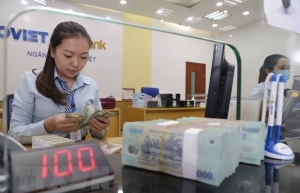Investors need to have the right mindset to bonds
 |
At the event, on selecting stock portfolios, Techcom Securities specialist Nguyen Thi Hoat said that over the past three years, more attention has been paid to listed bonds, leading corporate bonds, and short-term bonds. About $12-16 million per day are available to scoop up these bonds. At the end of October, the bond purchase balance reached $4 million per day. Some investors have withdrawn their money from different channels to buy listed bonds that are discounted to an attractive price.
However, the bond market is quite new, so it has some specific features. The issuing organisations are in a race over bond issuance and interest rates. However, the increase in quantity is not in line with the quality. Meanwhile, many investors, especially retail investors, still lack experience and insight into the market.
“Many investors consider corporate bonds as saving products, so they choose bonds based on interest rates. However, investors are really concerned about some violations in the announcement of bond issuance,” she said.
At the talk show, Le Hong Khang, Credit analytics manager at FiinRatings, stated that bonds are not saving products. The level of safety depends on interest rates. The higher the interest rates are, the higher the risks are.
The first is credit risk. This is the core risk that credit rating agencies like FiinRatings consider when evaluating issuers. FiinRatings does not rely on factors such as collateral and guarantees, but instead uses credit risk as the main factor to assess the debt repayment capacity of the issuer.
The second is liquidity risk. This is one of the risks that investors must understand very well and discuss with issuing organisations.
The third is the risk of pricing interest rates. In some cases, the returns that investors earn do not match the risks they face. This is mainly because they lack understanding of the business model. They opt for high interest rates, but do not understand the risks they face in the process of holding bonds and other risky investments.
Although evaluating an issuer or bond is quite complicated, Khang shares three important criterion for investors, both professional and non-professional. The investors should take this criterion into consideration before proceeding to buy and sell bonds.
The first criterion is financial leverage. Although it is necessary to take the business model into account, investors must recognize that a company with a lot of debt will be riskier than one with little debt. This is particularly true in the environment where there have been strong fluctuations in interest rates in the past few months. With a large financial leverage structure, enterprises will be partly affected by changes in the direction of higher interest rates.
The second criterion is the ability to pay interest on loans. This is an essential factor to consider. If the coefficient is less than 1, it means earnings before interest, taxes, and depreciation divided by interest expenses are less than 1. If this goes on for a long period of time, it is certain that the business will have difficulty keeping up with interest payments, even the principal of bonds.
The third criterion is the ability to repay the principal. To evaluate, FiinRatings uses the financial debt ratio divided by earnings before interest, depreciation, and taxes to make the calculation. For example, it takes 5 years to repay the principal of a bond, while the principal repayment period is only 2–3 years. In this case, the business will certainly have problems meeting the repayment schedule.
From the above analysis, economic expert Vu Dinh Anh suggests ways to deal with the issues. Investors, especially retail investors, should avoid the crowd effect. They must brush up on their skills and ability to analyse the market to avoid such behaviour, especially rumours.
 | New regulations enhance transparency in private placement of bonds The new decree on offering and trading private placement bonds helps standardise and improve bond issuance conditions, supervision of capital use purposes and information transparency, said analysts. |
 | Companies urged to engage in capital mobilisation efforts The restricted space for credit flow and the imminent maturation of a significant number of bonds is exerting pressure on the Vietnamese financial sector. |
 | Interest rates of auctioned Government bonds continue to rise The Hanoi Stock Exchange (HNX) held 30 auctions of Government bonds (G-bonds) in October, with 55.66 percent of the total G-bonds on offer, worth 31.45 trillion VND (1.26 billion USD) sold. |
What the stars mean:
★ Poor ★ ★ Promising ★★★ Good ★★★★ Very good ★★★★★ Exceptional
 Tag:
Tag:
Related Contents
Latest News
More News
- Ho Chi Minh City hits $8.37 billion in FDI (December 29, 2025 | 08:28)
- Tax sector wraps up 2025 and sets priorities for next year (December 25, 2025 | 14:00)
- Heavy industries set for pilot greenhouse gas quotas (December 25, 2025 | 10:00)
- $250 million deal targets women-owned SMEs, sustainable agriculture (December 22, 2025 | 17:40)
- UOB sees Vietnam growth easing in fourth quarter (December 22, 2025 | 17:39)
- Government moves to establish International Financial Centre (December 21, 2025 | 21:00)
- Vietnam's IFC to target global investment flows (December 21, 2025 | 18:00)
- Ha Tinh breaks ground on major Vingroup industrial and energy projects (December 19, 2025 | 18:24)
- EVN launches major power infrastructure projects nationwide (December 19, 2025 | 18:17)
- VAL inaugurates second production line to meet domestic animal feed demand (December 19, 2025 | 16:37)























 Mobile Version
Mobile Version